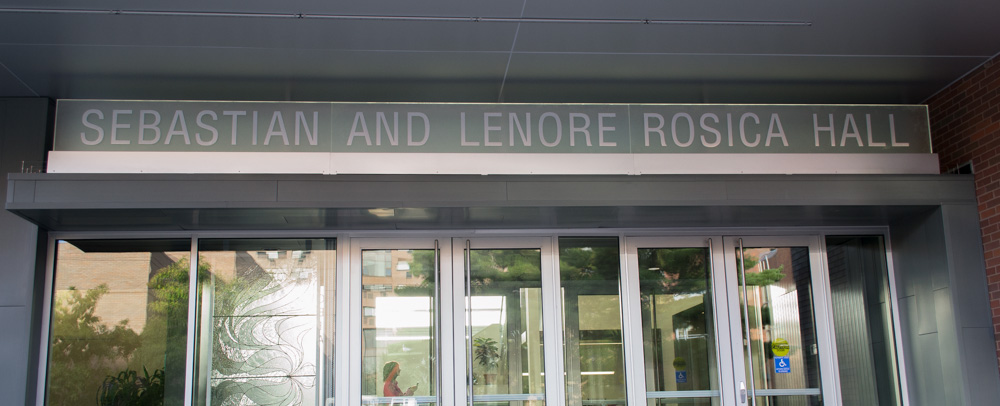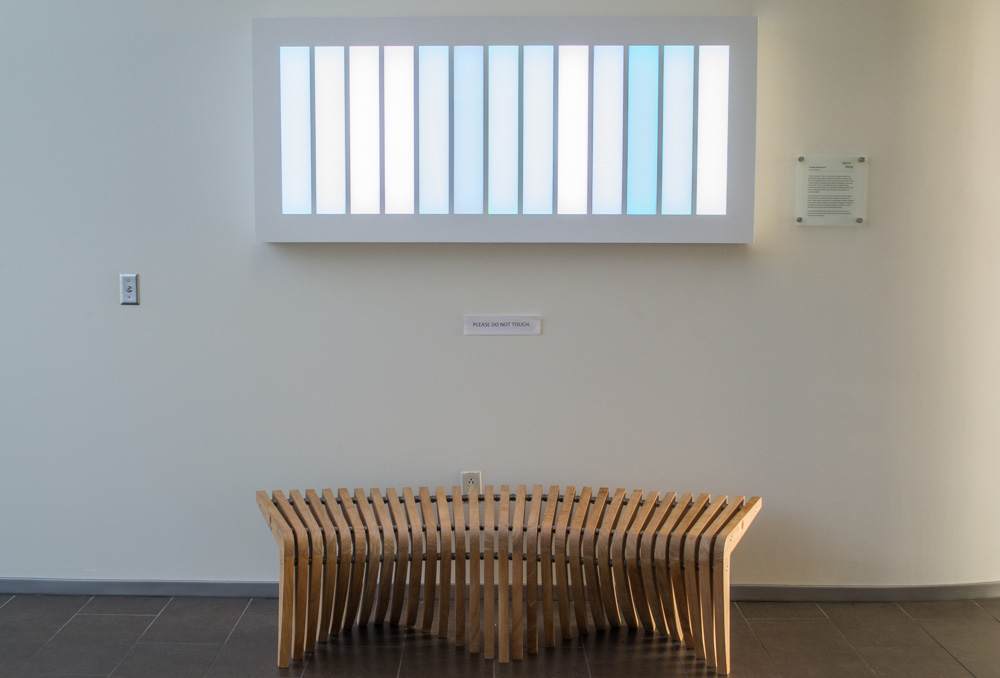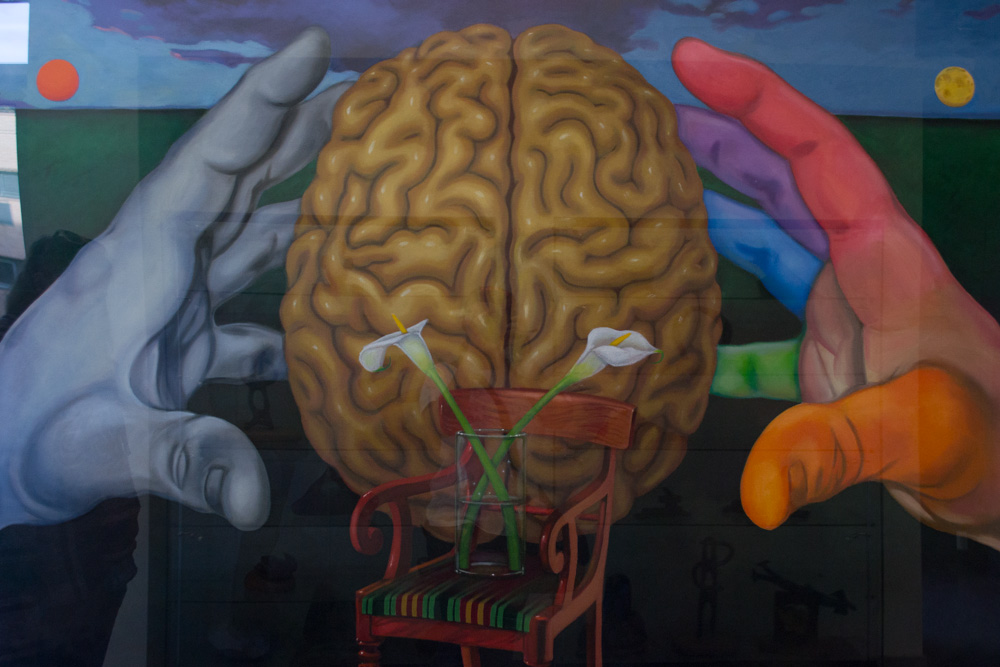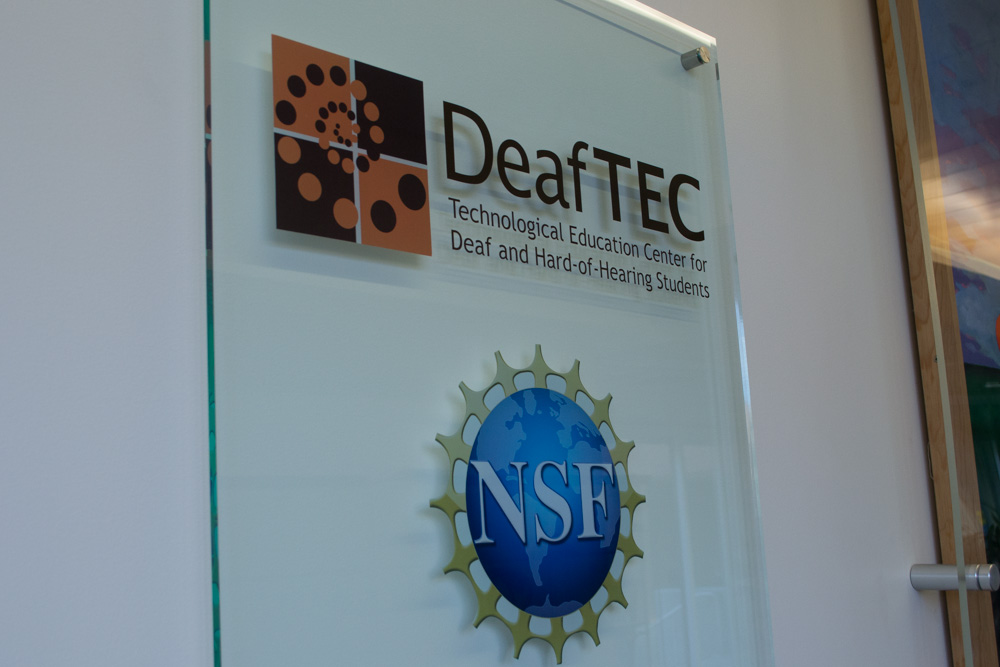Setting the Foundation
“From the minute we opened the door, the building was fully funded,” DeCaro said. With nearly
“This was a ‘build it and they will come’ effort,” Long said with a laugh. “We had some research groups that were funded, but the goal of this was to be a sort of research hub for students and faculty.”
Advocates of the facility hoped to forge new ties between the deaf, hard-of-hearing and hearing students and faculty alike, citing RIT’s watchword “innovation” as the core of Rosica Hall’s intended mission. Specifically, NTID’s webpage for the hall cites “development and adaptation of access and instructional technologies” and “innovative cross-disciplinary projects involving science-, engineering-, imaging- and business-related fields” as its design intent.
Prior to the official opening of the building in 2013, NTID hosted the university-wide Rosica Research Festival in September of that year. There, researchers from RIT and NTID set up displays and talked about their research activity, with the goal of expanding public awareness of the hall and its endeavors.
Now, over one year later,
Additionally, the building contains a wide range of facilities: conference rooms, an ‘Imaginarium’ and even a meditation garden. The aforementioned centers and their administration are housed on the first floor, while the second floor contains laboratories and multi-purpose spaces.
Inside the Flex Space
Adaptability is a prominent aspect of the hall that has been emphasized by its proponents both before and after its completion.
HBT Architects kept this concept in mind for their space planning of Rosica Hall. Touchdown spaces with seating and tables are located at every turn. Wide hallways leave room for chance encounters and conversations, as well as extensive lines of sight from different vantage points in each space – a crucial aspect of ASL-friendly design. Brick walls and solidity have been all but rejected in favor of strong natural light and frosted glass partitions that allow curious onlookers to witness the silhouetted activity inside. These integral design elements came from a report of recommendations written by Phil Reuben, one of DeCaro's past Civil Engineering students who is now a successful architect.
During original discussions with the architects on the project, accordion-style room dividers were considered but rejected in favor of simple internal walls that do not contain any electrical, plumbing or structural elements. That way, if a research facility receives grant money several years down the road, the spaces can be reconfigured to accommodate yet another research initiative or center.
When asked about whether or not there are any concerns regarding the loss of ‘flex space’ as grants are acquired and rooms are repurposed, DeCaro answered “Yes ... but it’s a problem that comes from success. I love that sort of thing.”
For now, there is plenty of flex space that comes with adaptable furniture as well. “All furnishings can be mixed and matched,” DeCaro said of the bright green, orange and purple furnishings as he pushed open the door to an interview room.
“And they have been
Rosica Hall students and faculty alike have taken to ‘borrowing’ furniture and rearranging it freely to suit their purposes.
Students have also been quick to take advantage of the variety of writing surfaces in the hall, including movable whiteboards and walls with invisible coating that makes nearly every vertical surface a viable space for writing. Indeed, DeCaro and Long admitted with amusement, Rosica Hall students have become so accustomed to having the writable surfaces that the faculty have had to place signs on desks, tabletops and walls coated in regular sealants that specifically warn people that they are not included in the scope of writable surfaces.
Rearranging Research
Rosica Hall has also had an impact beyond the physical space it provides students and faculty. “This has been a complete change in the way that research is organized at NTID,” DeCaro said.
He cited
The document was compiled by NTID in 2010 in the form of a 10-year plan that essentially serves as a road map for NTID. It explores "strategic initiatives" in student involvement, program development, cross-college communication and countless other critical components to foster innovation. By consolidating the efforts that were happening with varying levels of awareness all over NTID and RIT, Rosica Hall’s advocates gave research a place where it would be recognized.
For example, Ron Kelly, the REACH Center director, participates in work on stereotype threat and associated issues, which recently earned REACH a
In relating Rosica Hall’s nontraditional research methods, DeCaro also spoke of the ‘teacher-scholar’ model that Rosica Hall promotes. “The idea is that your teaching informs your research, and your research informs your teaching.” That way, the center can explore and bring issues to attention that faculty feel RIT needs to address.
This concept is exemplified in the work of Carol Marchetti, whose Rosica Hall efforts take place in the
Marchetti’s teaching methods include separating students into groups and forming ‘mixed’ teams of deaf, hearing and hard-of-hearing students. The groups are then encouraged to take advantage of Rosica Hall’s tools for communication, which include the rolling chairs that can be moved into circular formations for clear lines of sight, the portable whiteboards and the walls with coating.
“It changes the way they work together,” Marchetti said. “Standing, there’s just a different energy in the room. They’re more engaged that way.”
DeCaro indicated the whiteboards, commenting “This is low-tech but with a high-tech strategy!”
It seems that with Rosica Hall it’s not a question of what it has done so far, but rather where it’s going next. “People ask me, ‘What’s going on? What are you doing?’” DeCaro said, shaking his head with a laugh. “I tell them ‘Whoa, calm down.’”
He smiled. “We’re doing fine.”











